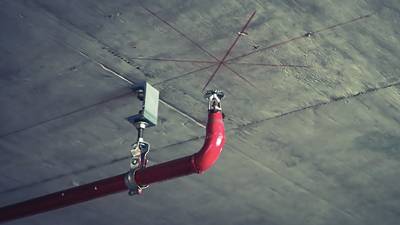Research And Insight
Sprinkler system types
Fire installation types – wet system, dry system, deluge and pre-action systems – are dependent on the temperature (frost or no frost) and the activation method for the fire system.
Sprinkler systems are intended to either control or to suppress the fire. The fire is not extinguished before the burning materials are exhausted or manually extinguished by fire fighters. Consulting or Designing engineers select different types of installations depending on the building type and the usage of the building.
Wet pipe systems
Wet pipe sprinkler systems are the most common system. The pipes are filled with water under pressure and are only installed in frost resistant building areas. Since they are simple, they are also very reliable.
When an automatic sprinkler is exposed for a sufficient time to a temperature at or above the temperature rating, the heat-sensitive element (for example a glass bulb) breaks, allowing water (held under pressure) to flow from the sprinkler.
Dry pipe systems
Dry pipe systems are installed in spaces where the ambient temperature may be cold enough to freeze the water in a wet pipe system, making a wet pipe system inoperable. Dry pipe systems are typically used in refrigerated coolers, car parking area and in unheated buildings or water sensitive areas, since dry pipe systems do not leak water.
The sprinkler piping is filled with pressurised air. A special alarm valve is used to separate the sprinkler pipe and the water supply pipe. When one or more of the automatic sprinklers is exposed to a temperature at or above the temperature rating, it opens, allowing the air in the piping to vent from that sprinkler.
As the air pressure in the piping drops, the pressure difference across the alarm valve changes, the alarm valve will open, allowing water to enter the piping system. The water flow from the sprinklers is delayed until the air is vented from the sprinklers.
Dry pipe systems are therefore not as fast-acting in the initial phase of a fire. But the only delay before water is distributed via the sprinklers is from the time to vent the air from the pipe. This means that the potential for severe water damage exists.
Deluge systems
Deluge systems are systems where all connected sprinklers are open. These sprinklers have no sensing element (glass bulb). Deluge systems are used in areas where there is a concern for a rapid-fire spread. The open sprinklers will distribute water over the entire area.
The piping is filled with atmospheric pressure, and a mechanically-activated deluge valve will open in case of fire, enabling the water to fill the sprinkler pipe. The deluge valve is activated by a signal from a fire alarm system and remains open once it has been activated. The fire alarm system consists of smoke or heat detectors activating the alarm system, which opens the deluge valve.
Pre-action systems
Pre-action sprinkler systems are specialised for use in locations where accidental activation is undesired. This may be museums, special technology companies, data centers with lots of computers etc.
Grundfos supplies fire pumps for water supply to different types of fire sprinkler systems for industrial and commercial fire protection.









